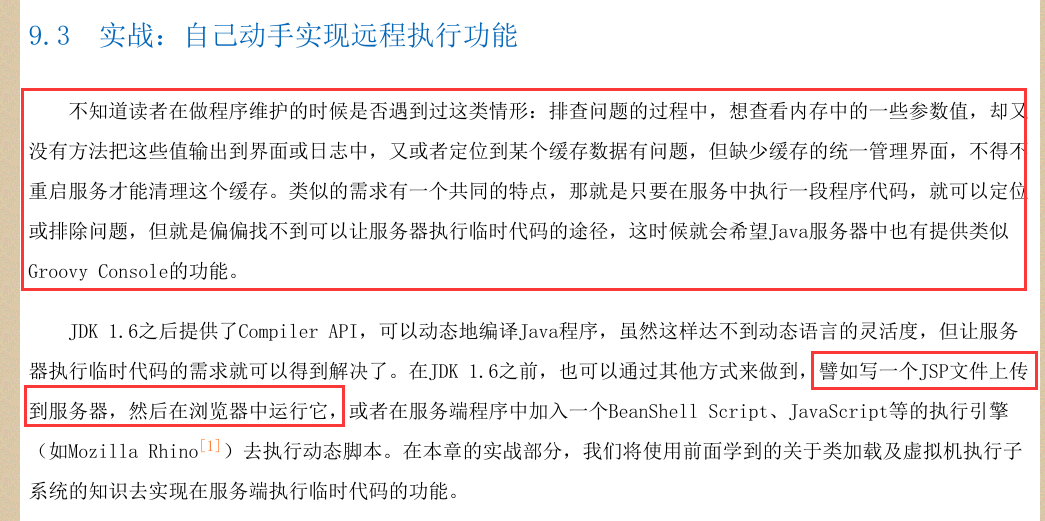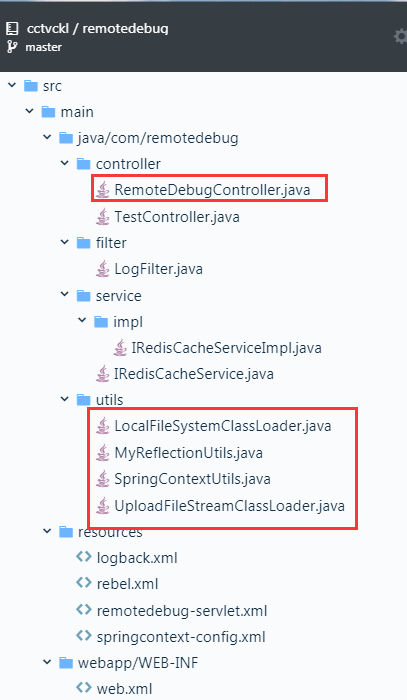@Java Web 程序员,我们一起给程序开个后门吧:让你在保留现场,服务不重启的情况下,执行我们的调试代码
一、前言
这篇算是类加载器的实战第五篇,前面几篇在这里,后续会持续写这方面的一些东西。
实战分析Tomcat的类加载器结构(使用Eclipse MAT验证)
- 从数据库、redis取了些数据,做了一些运算后,没抛异常,但是就是结果不对
- 抛了个空指针异常,但是看代码,感觉没问题,是取出来就是空,还是中间什么函数把它改坏了
- 发现导致一个bug的原因是用了JVM缓存,但是怎么清理呢?难道重启?
- redis 数据不对,能不能悄咪咪重新拉一下
- 好想把某个全局变量打出来看一下?好想执行一个数据库查询,看看他么的结果对不对?
- 。。。
哎,程序员的世界,从来没有容易二字。 说实话,我们这次要开的后门就是做上面这些事情的,我刚鼓捣出这个时,我感觉这个还挺shock,为啥大佬们不去弄呢,后来我偶然想到,在 周志明大佬的那本 《Java 虚拟机:JVM高级特性与最佳实践》书里,提到过类似的解决思路。就在书的 9.3 节,如下图,这里就提到了类似的需求,就是要在不停服务情况下,动态执行代码,方案其实一直都有:将自己的调试代码写到JSP里,丢到服务器上,然后访问该JSP。

我们要做的事情,其实有点类似JSP,比它好的地方在于:不用把文件手动丢到服务器上,直接上传class就行了。 也正是因为这次的折腾,我才知道,JSP原来还是能做很多事情的。但是笔者在毕业时,JSP应用基本就很少了,大学学了点皮毛而已,工作后更是没用到,但它的类加载器的思想还是值得我们学习的。
二、大体思路与展示
1、思路
我们的目标是,针对一个 spring mvc 开发的部署在tomcat 上的 war 包应用,不重启的情况下,动态执行一些我们的调试代码,调试代码中,只要是原项目能用的东西,我们都可以用。具体的方式是,在项目中 增加一个Controller,该Controller 的接口,主要是接收客户端传过来的调试类的 class 文件,或者去指定的 url 加载调试类的 class,然后用自定义类加载器加载该 class,new出对象,并执行我们指定的方法。
下面我先简单介绍下演示项目:
应用是 spring MVC + spring(演示用,就没有db层),内部有一个测试用的 Controller:
1 // TestController.java 2 3 package com.remotedebug.controller; 4 5 import com.remotedebug.service.IRedisCacheService; 6 import org.springframework.beans.factory.annotation.Autowired; 7 import org.springframework.web.bind.annotation.RequestMapping; 8 import org.springframework.web.bind.annotation.RequestParam; 9 import org.springframework.web.bind.annotation.RestController; 10 11 /** 12 * desc: 13 * 测试接口,模拟从redis中获取缓存。当然,实际场景下,看缓存可以直接用工具的,这里就是举个栗子 14 * @author : caokunliang 15 * creat_date: 2019/6/18 0018 16 * creat_time: 10:13 17 **/ 18 @RestController 19 public class TestController { 20 21 @Autowired 22 private IRedisCacheService iRedisCacheService; 23 24 /** 25 * 缓存获取接口 26 * @param cacheKey 27 */ 28 @RequestMapping("getCache.do") 29 public String getCache(@RequestParam String cacheKey){ 30 String value = iRedisCacheService.getCache(cacheKey); 31 System.out.println(value); 32 33 return value; 34 } 35 }
1 // IRedisCacheServiceImpl.java 2 package com.remotedebug.service.impl; 3 4 import com.remotedebug.service.IRedisCacheService; 5 import lombok.extern.slf4j.Slf4j; 6 import org.springframework.stereotype.Service; 7 8 import java.util.List; 9 10 /** 11 * desc: 12 * 13 * @author : caokunliang 14 * creat_date: 2019/6/18 0018 15 * creat_time: 10:17 16 **/ 17 @Service 18 @Slf4j 19 public class IRedisCacheServiceImpl implements IRedisCacheService { 20 21 @Override 22 public String getCache(String cacheKey) { 23 String target = null; 24 // ----------------------前面有复杂逻辑-------------------------- 25 String count = getCount(cacheKey); 26 // ----------------------后面有复杂逻辑,包括对 count 进行修改-------------------------- 27 if (Integer.parseInt(count) > 1){ 28 target = "abc"; 29 }else { 30 // 一些业务逻辑,但是忘记给 target 赋值 31 // ..... 32 } 33 34 return target.trim(); 35 } 36 37 @Override 38 public String getCount(String cacheKey){ 39 // 假设是从redis 读取缓存,这里简单起见,假设value的值就是cacheKey 40 return cacheKey; 41 } 42 }
注意上面的实现类,getCache 方法,就是简单地去调用了 getCount 方法,然后做了一些复杂计算,在 else 分支,我们没给 target 赋值,所以 在 34 行调用 target.trim 时会抛NPE。我们这时候排查问题时,如果能够调用 getCount 看到返回的值是多少,就好了!
知道了getCount 返回值,我们就可以接着看到底是返回的值有问题,还是是因为后面的逻辑有问题了。 常规情况下,我们是没办法的,只能肉眼看了,或者本地调试,但本地调试,取到的数据又不是真实环境的,很可能不能复现。
我们现在就可以写一段下面这样的代码,放到服务器上执行,就可以将我们需要的信息打出来了:
import com.remotedebug.service.IRedisCacheService; import com.remotedebug.utils.SpringContextUtils; import lombok.extern.slf4j.Slf4j; @Slf4j public class RemoteDebugTest { public void debug(){ IRedisCacheService bean = SpringContextUtils.getBean(IRedisCacheService.class); String value = bean.getCount("user.count.userIdxxx"); log.info("value:{}", value ); } public static void main(String[] args) { new RemoteDebugTest().debug(); } }
ps:这里的 SpringContextUtils 只是一个简单的工具类,spring 容器会把自己赋值给 SpringContextUtils 中一个静态变量,方便我们在一些不被spring 管理的bean中获取 bean。
那要怎么才能让服务器执行我们的 RemoteDebugTest 的 debug 方法呢,你可能想到了,我们再加一个 Controller 就行了:

1 package com.remotedebug.controller;
2
3 import com.remotedebug.utils.LocalFileSystemClassLoader;
4 import com.remotedebug.utils.MyReflectionUtils;
5 import com.remotedebug.utils.UploadFileStreamClassLoader;
6 import lombok.extern.slf4j.Slf4j;
7 import org.springframework.stereotype.Controller;
8 import org.springframework.web.bind.annotation.RequestMapping;
9 import org.springframework.web.bind.annotation.RequestParam;
10 import org.springframework.web.bind.annotation.ResponseBody;
11 import org.springframework.web.multipart.MultipartFile;
12
13 import java.io.InputStream;
14
15 /**
16 * desc:
17 * 原理:自定义类加载器,根据入参加载指定的调试类,调试类中需要引用webapp中的类,所以需要把webapp的类加载器作为parent传给自定义类加载器。
18 * 这样就可以执行 调试类中的方法,调试类中可以访问 webapp中的类,所以通过 spring 容器的静态引用来获取spring中的bean,然后就可以执行很多业务方法了。
19 * 比如获取系统的一些状态、执行service/dao bean中的方法并打印结果(如果方法是get类型的操作,则可以获取系统状态,或者模拟取redis/mysql库中的数据,如果
20 * 为update类型的service 方法,则可以用来改变系统状态,在不用重启的情况下,进行一定程度的热修复。
21 * @author : caokunliang
22 * creat_date: 2018/10/19 0019
23 * creat_time: 14:02
24 **/
25 @Controller
26 @Slf4j
27 public class RemoteDebugController {
28
29
30 /**
31 * 远程debug,读取参数中的class文件的路径,然后加载,并执行其中的方法
32 */
33 @RequestMapping("/remoteDebug.do")
34 @ResponseBody
35 public String remoteDebug(@RequestParam String className ,@RequestParam String filePath, @RequestParam String methodName) throws Exception {
36 /**
37 * 获取当前类加载器,当前类肯定是放在webapp的web-inf下的classes,这个类所以是由 webappclassloader 加载的,所以这里获取的就是这个
38 */
39 ClassLoader webappClassloader = this.getClass().getClassLoader();
40 log.info("webappClassloader:{}",webappClassloader);
41
42
43 /**
44 * 用自定义类加载器,加载参数中指定的filePath的class文件,并执行其方法
45 */
46 log.info("开始执行:{}中的方法:{}",className,methodName);
47 LocalFileSystemClassLoader localFileSystemClassLoader = new LocalFileSystemClassLoader(filePath, className, webappClassloader);
48 Class<?> myDebugClass = localFileSystemClassLoader.loadClass(className);
49 MyReflectionUtils.invokeMethodOfClass(myDebugClass, methodName);
50
51 log.info("结束执行:{}中的方法:{}",className,methodName);
52
53 return "success";
54
55 }
56
57
58 /**
59 * 远程debug,读取参数中的class文件的路径,然后加载,并执行其中的方法
60 */
61 @RequestMapping("/remoteDebugByUploadFile.do")
62 @ResponseBody
63 public String remoteDebugByUploadFile(@RequestParam String className, @RequestParam String methodName, MultipartFile file) throws Exception {
64 if (className == null || file == null || methodName == null) {
65 throw new RuntimeException("className,file,methodName must be set");
66 }
67
68 /**
69 * 获取当前类加载器,当前类肯定是放在webapp的web-inf下的classes,这个类所以是由 webappclassloader 加载的,所以这里获取的就是这个
70 */
71 ClassLoader webappClassloader = this.getClass().getClassLoader();
72 log.info("webappClassloader:{}",webappClassloader);
73
74 /**
75 * 用自定义类加载器,加载参数中指定的class文件,并执行其方法
76 */
77 log.info("开始执行:{}中的方法:{}",className,methodName);
78 InputStream inputStream = file.getInputStream();
79 UploadFileStreamClassLoader myClassLoader = new UploadFileStreamClassLoader(inputStream, className, webappClassloader);
80 Class<?> myDebugClass = myClassLoader.loadClass(className);
81 MyReflectionUtils.invokeMethodOfClass(myDebugClass, methodName);
82 log.info("结束执行:{}中的方法:{}",className,methodName);
83
84
85 return "success";
86
87 }
88
89
90 /**
91 * 远程debug,读取参数中url指定的class文件的路径,然后加载,并执行其中的方法
92 */
93 @RequestMapping("/remoteDebugByURL.do")
94 @ResponseBody
95 public String remoteDebugByURL(@RequestParam String className,@RequestParam String url, @RequestParam String methodName) throws Exception {
96 if (className == null || url == null || methodName == null) {
97 throw new RuntimeException("className,url,methodName must be set");
98 }
99
100 /**
101 * 获取当前类加载器,当前类肯定是放在webapp的web-inf下的classes,这个类所以是由 webappclassloader 加载的,所以这里获取的就是这个
102 */
103 ClassLoader webappClassloader = this.getClass().getClassLoader();
104 log.info("webappClassloader:{}",webappClassloader);
105
106 /**
107 * 用自定义类加载器,加载参数中指定的class文件,并执行其方法
108 */
109 log.info("开始执行:{}中的方法:{}",className,methodName);
110 UploadFileStreamClassLoader myClassLoader = new UploadFileStreamClassLoader(url, className, webappClassloader);
111 Class<?> myDebugClass = myClassLoader.loadClass(className);
112 MyReflectionUtils.invokeMethodOfClass(myDebugClass, methodName);
113 log.info("结束执行:{}中的方法:{}",className,methodName);
114
115
116 return "success";
117 }
118 }
在这个 Controller 中,一共提供了三种方式,先说最直接的,就是通过上传 class 文件,这个很简单,只要有一个接口工具(如 postman)就可以。 Controller 中会 用自定义类加载器,去加载 文件流 代表的class,然后 new出对象,调用方法就行了。
2.效果展示
我的应用部署在 192.168.19.13上,Tomcat 端口为 8081,如下:
[root@localhost apache-tomcat-8.0.41]# ll webapps/
total 9336
drwxr-xr-x. 14 root root 4096 Jun 19 11:39 docs
drwxr-xr-x. 6 root root 4096 Jun 19 11:39 examples
drwxr-xr-x. 5 root root 4096 Jun 19 11:39 host-manager
drwxr-xr-x. 5 root root 4096 Jun 19 11:39 manager
drwxr-xr-x. 4 root root 4096 Jun 19 13:48 remotedebug
-rw-r--r--. 1 root root 9531510 Jun 19 13:47 remotedebug.war
drwxr-xr-x. 3 root root 4096 Jun 19 11:39 ROOT
我们在本地写好一个测试文件,(可以直接在 工程 里面写,这样才方便引用工程的类,不然还要自己敲 import 路径,那也太傻了),写好后,右键 执行下 main,触发编译操作。
执行main,肯定会报错,这是不用说的,但我们只需要 class 而已:

我们去 target 目录下,找到编译出来的 class,然后用 接口工具调用,如下:

下面我们看看执行结果:

然后我再改下测试类的debug方法:
public void debug(){
IRedisCacheService bean = SpringContextUtils.getBean(IRedisCacheService.class);
String value = bean.getCount("123456789");
log.info("value:{}", value );
}
再次执行:

三、源码解析
代码我放在交友网站了,欢迎fork。
https://github.com/cctvckl/remotedebug
类结构如下:

我们重点分析 remoteDebugByUploadFile :
1 /**
2 * 远程debug,读取参数中的class文件的路径,然后加载,并执行其中的方法
3 */
4 @RequestMapping("/remoteDebugByUploadFile.do")
5 @ResponseBody
6 public String remoteDebugByUploadFile(@RequestParam String className, @RequestParam String methodName, MultipartFile file) throws Exception {
7 if (className == null || file == null || methodName == null) {
8 throw new RuntimeException("className,file,methodName must be set");
9 }
10
11 /**
12 * 获取当前类加载器,当前类肯定是放在webapp的web-inf下的classes,这个类所以是由 webappclassloader 加载的,所以这里获取的就是这个
13 */
14 ClassLoader webappClassloader = this.getClass().getClassLoader();
15 log.info("webappClassloader:{}",webappClassloader);
16
17 /**
18 * 用自定义类加载器,加载参数中指定的class文件,并执行其方法
19 */
20 log.info("开始执行:{}中的方法:{}",className,methodName);
21 InputStream inputStream = file.getInputStream();
22 UploadFileStreamClassLoader myClassLoader = new UploadFileStreamClassLoader(inputStream, className, webappClassloader);
23 Class<?> myDebugClass = myClassLoader.loadClass(className);
24 MyReflectionUtils.invokeMethodOfClass(myDebugClass, methodName);
25 log.info("结束执行:{}中的方法:{}",className,methodName);
26
27
28 return "success";
29
30 }
其中,14,15行,主要获取当前的 webappclassloader 加载器,该加载器,通俗来讲,就是加载应用目录下的 web-inf/lib 和 web-inf/classes。 21 行,主要获取文件流; 22行,将流、要加载的class的类名、webappclassloader 作为参数,来生成 自定义的类加载器,其中 webappclassloader 将作为 我们自定义类加载器的 双亲加载器。 23行,用自定义类加载器加载我们的类; 24行,用加载类反射,生成对象,并执行 methodName指定的方法。
重点代码在 UploadFileStreamClassLoader,我们看一下:
1 package com.remotedebug.utils; 2 3 import lombok.extern.slf4j.Slf4j; 4 5 import java.io.ByteArrayOutputStream; 6 import java.io.IOException; 7 import java.io.InputStream; 8 import java.io.UnsupportedEncodingException; 9 import java.net.URL; 10 import java.net.URLConnection; 11 12 /** 13 * desc: 14 * 15 * @author : caokunliang 16 * creat_date: 2019/6/13 0013 17 * creat_time: 10:19 18 **/ 19 @Slf4j 20 public class UploadFileStreamClassLoader extends ClassLoader { 21 /** 22 * 要加载的class的类名 23 */ 24 private String className; 25 /** 26 * 要加载的调试class的流,可以通过客户端文件上传,也可以通过传递url来获取 27 */ 28 private InputStream inputStream; 29 30 /** 31 * 32 * @param inputStream 要加载的class 的文件流 33 * @param className 类名 34 * @param parentWebappClassLoader 父类加载器 35 */ 36 public UploadFileStreamClassLoader(InputStream inputStream, String className, ClassLoader parentWebappClassLoader) { 37 super(parentWebappClassLoader); 38 this.className = className; 39 this.inputStream = inputStream; 40 } 41 42 43 44 @Override 45 protected Class<?> findClass(String name) throws ClassNotFoundException { 46 byte[] data = getData(); 47 try { 48 String s = new String(data, "utf-8"); 49 // log.info("class content:{}",s); 50 51 } catch (UnsupportedEncodingException e) { 52 e.printStackTrace(); 53 } 54 return defineClass(className,data,0,data.length); 55 } 56 57 private byte[] getData(){ 58 try { 59 ByteArrayOutputStream byteArrayOutputStream = new ByteArrayOutputStream(); 60 byte[] bytes = new byte[2048]; 61 int num = 0; 62 while ((num = inputStream.read(bytes)) != -1){ 63 byteArrayOutputStream.write(bytes, 0,num); 64 } 65 66 return byteArrayOutputStream.toByteArray(); 67 } catch (Exception e) { 68 log.error("read stream failed.{}",e); 69 throw new RuntimeException(e); 70 } 71 } 72 }
重点关注 46 行和 54行,46行主要是 从流中读取字节,转为字节数组; 54行主要是将字节数组代表的 class 加载到虚拟机中。另外,这里我们只覆盖了 findClass,是遵循双亲委派模型的,可以注意到,我们的测试类中,import了一些工程的类,比如:
1 import com.remotedebug.service.IRedisCacheService;
2 import com.remotedebug.utils.SpringContextUtils;
3 import lombok.extern.slf4j.Slf4j;
4
5
6 @Slf4j
7 public class RemoteDebugTest {
8 public void debug(){
9 IRedisCacheService bean = SpringContextUtils.getBean(IRedisCacheService.class);
10 String value = bean.getCount("123456789");
11
12 log.info("value:{}", value );
13 }
14
15 }
在加载这些类时,我们自定义的类加载器会先委托给父类加载器加载,而且,我们自定义的类加载器自身也加载不了这些类。这里有个关键点在于,我们为什么要把 应用的当前类加载器传入作为自定义加载器的父加载器呢,因为不同类加载器加载出来的 class,不能互转,所以我们必须用 同一个类加载器实例。
四、使用说明
上面详细讲述了代码实现,这里,汇总一下,我们这边一共提供了三个接口:
-
remoteDebug.do 参数:@RequestParam String className ,@RequestParam String filePath, @RequestParam String methodName
该接口,主要是从本地文件系统加载 filepath 指定的文件,所以这个接口,需要先把class 文件 上传到 服务器的某个路径下。
-
remoteDebugByUploadFile.do 参数: @RequestParam String className, @RequestParam String methodName, MultipartFile file
该接口,可以直接上传class文件,要支持文件上传,需要进行以下配置:
<bean
class="org.springframework.web.multipart.commons.CommonsMultipartResolver">
<property name="defaultEncoding" value="utf-8" />
<property name="maxUploadSize" value="10485760000" />
<property name="maxInMemorySize" value="40960" />
</bean>
同时,我这边的环境不知道为啥,还需要修改web.xml(我们其他项目中都没配这个,尴尬):
<servlet>
<servlet-name>DispatcherServlet</servlet-name>
<servlet-class>org.springframework.web.servlet.DispatcherServlet</servlet-class>
<init-param>
<param-name>contextConfigLocation</param-name>
<param-value>classpath*:/remotedebug-servlet.xml</param-value>
</init-param>
<load-on-startup>1</load-on-startup>
<multipart-config>
<location></location>
<max-file-size>20848820</max-file-size>
<max-request-size>418018841</max-request-size>
<file-size-threshold>1048576</file-size-threshold>
</multipart-config>
</servlet>
-
remoteDebugByURL @RequestParam String className,@RequestParam String url, @RequestParam String methodName
该接口,可接受一个网络url,从url 去加载指定的class。

五、总结
一开始没想鼓捣这个,只是后边学了类加载器后,感觉是不是可以利用其来做点什么,于是想到了这个。因为热替换,是不可能在同一个类加载器实例中重复加载同一个类的,所以目前的热替换都是连根拔起,将类加载器一起换掉。在 web 应用中,web-inf下的classes和lib 都由唯一的一个类加载器加载,要替换其中的单个类,暂时没想到什么办法,但是我就感觉,可以用一个单独的类加载器去加载指定的一个位置(不同于 web-inf的位置),然后每次不用这个类,就把加载器一起丢了就行。然后一开始不知道可行,直到做出来试了后,发现确实没有问题,理论上也能解释。 后来,我在和同事讨论的过程中,感觉我做的这个东西,和JSP很像,然后又想到 在周志明的那本书里,好像有过类似的案例,去看了下,果然如此。。。
哈哈,好吧,我还以为是很新鲜的东西,原来大佬早就玩过了,JSP更是出现了不知道多少年了,只是以前没怎么玩过JSP。
这个方法,也是适用于 spring boot 的,只是需要稍微修改一下,后续我再稍微改改,发个spring boot 的版本出来。类加载器这个东西还是挺有用,后续我会继续更新这方面的文章,包括 SPI、osgi(皮毛),各类框架中 类加载器的应用等,也希望和大家多多交流,共同交流才能一起进步嘛。
源码再发一下,在这里: https://github.com/cctvckl/remotedebug
不同于之前的文章,这次排版改了下,比如字体变大了,有些段落换了颜色,大家觉得比默认的好看还是不好看?



 浙公网安备 33010602011771号
浙公网安备 33010602011771号